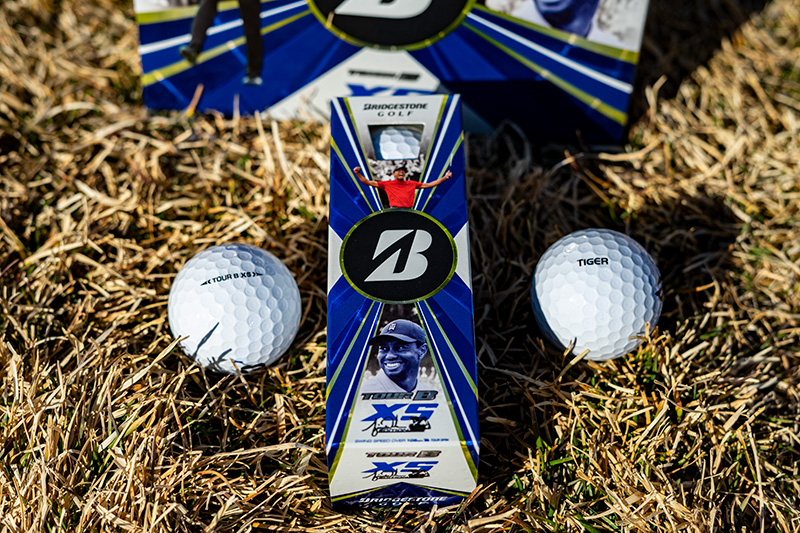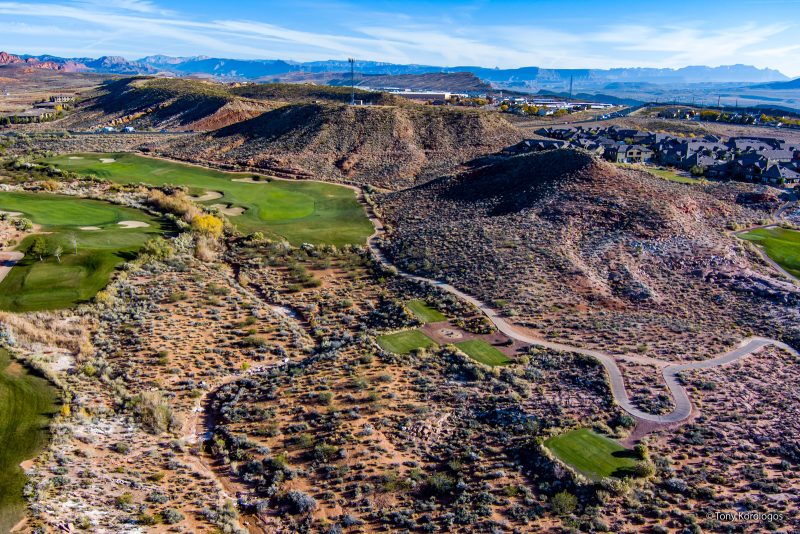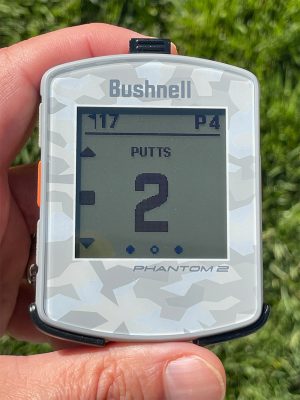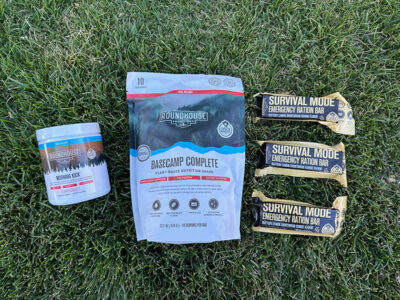First Look: Bridgestone Golf Tour B XS Tiger Woods Edition Golf Ball
Categories: Golf Balls • Golf Equipment • Golf Gear • Tiger Woods
Tags: Bridgestone • Bridgestone Golf • Tiger Woods
In for review from Bridgestone Golf is the new Tour B XS Tiger Woods Edition. I really dig the packaging and presentation in the box and sleeves. Each ball is marked with the word TIGER.

The Tour B XS is designed for golfers with a driver swing speed over 105 miles per hour. Probably right on the edge of my range at this point in my golf career, with age and a major shoulder surgery in play.
Distance
According to Bridgestone the ball delivers even “more distance.” I have yet to see a new golf ball come out that claims, “less distance.” 🙂

Tour Spin
The cover of the ball features REACTiViQ technology; a smart cover that reacts to the force of impact. The ball stays in contact with the club longer, allowing the player to impart more control in the short game and work the ball with the irons and metal-woods.
HOG Aerial World Tour – Coral Canyon, Utah
Categories: Aerial Photography • Golf • Golf Course Architecture • Golf Courses • Golf For Women • Golf Life • Golf Lifestyle • HOG World Tour
Tags: Golf Utah • Southern Utah • Utah Golf
Last weekend I was thrilled to make the road trip from northern Utah to Vegas to see my Utah Utes WIN the Pac-12 football championship, 38-10 over #10 Oregon. Since I always bring multiple drones with me when I travel, I made a stop by Coral Canyon to take a break from driving and catch a few drone photos.

Coral Canyon is a very fun course; desert target style with wide open landing areas.

There are many fun risk-reward scenarios and fun launching pads from the tops of dunes to fairways far below the tee box.

Bushnell Phantom 2 Golf GPS
Categories: Golf Accessories • Golf Equipment • Golf For Women • Golf Gear • Golf Gifts • Reviews
Tags: Bushnell Golf • Christmas Golf Gift • Gift Guide • Holiday Golf Gift
Cool golf gear alert! I’ve been testing out the new Bushnell Phantom 2 Golf GPS for a few weeks. Thrilled to have it, as my original Bushnell Phantom was lost/stolen. I’ll cover that more in a minute. First. let’s take a look at the Phantom 2.

Features
The Phantom 2 provides GPS data for over 38,000 golf courses around the globe. I haven’t visited a course yet with either my original Phantom or the Phantom 2 that didn’t pop right up on the courses list (below).

The data includes front, center and back yardages. Knowing something other than center is strategically beneficial so one can choose the appropriate shot in terms of risk, carry, and optimal distance.
The yardages (pictured below) are shown in very large, easy-to-read numbers. Even if the unit is on your bag or golf cart several feet away the yardages are easy to read.
The unit automatically detects when the golfer moves to the next hole and advances the data to that hole. Of course, the user can manually control which hole he is on in the event of some…. “errant” shots.

The unit is pocket sized, small and light. It’s easy to carry in a pocket, but also comes with a clip for clipping it onto a bag or a belt. The clip features a loop so the unit can be attached to a golf bag with a carabiner. The back features a strong magnet to stick it to the supports of a golf cart. Pay close attention to where you put it.*
Each golf hole can have up to six hazard/layup distances per hole. This is extremely useful information, especially for that first time on a course when the player is unsure what to hit and how far the hazards and carries are.

The green-view screen is very informative and useful. It shows the shape of the green and allows the user to cycle through the different pin placements, showing the yardage for each pin placement. This is vital information which will help the player choose the right club and avoid missing greens and/or three-putts.
The player can track each shot, including putts. Below I’ve 2-putted the 17th.

The unit doesn’t just count up shots, it also tracks shot direction and distance so the user can analyze the round later and use that recon for improvement. Knowing what to work on is fantastic. Missing a bunch of fairways to the left? AIM RIGHT! LOL.

The internal battery lasts up to 18 hours, perfect for those summer solstice day-long marathons! The battery is charged via USB-C. Nice that it isn’t an odd and hard to find proprietary cable.
Lastly, the unit features a cool gray camo look.
Final Thoughts
The features packed into an affordable $129.00 retail price for the Phantom 2 are many. Yardages are quick and convenient, as is shot tracking. Play with confidence in your choices, knowing the proper distances, hazards, and pin placements.
*Beware of attaching the unit to a golf cart! I used my original Phantom this way until the day I forgot to take it off the cart. Despite the fact that I’d played the fanciest private club in town, by the time I realized I’d left the unit on the card and ran back to the clubhouse, the Phantom was gone.
Happy Halloween – Bandon Dunes Style
Categories: Aerial Photography • Golf Courses • Miscellaneous
Tags: Bandon Dunes
Happy Halloween to all HOG readers….uh, I mean, “Patrons.” Trying to find a suitable “scary” golf photo for today was easy. I have a lot of awesomely creepy and mysterious pics from my last trip to Bandon Dunes Golf Resort. Checkout the path the the 2nd tee on the new Sheep Ranch Course:

Those are some scary trees right there.
Below the “marine layer” (a.k.a. fog) creeps up over the 16th fairway on the Sheep Ranch.

Old Macdonald was looking quite scary and mysterious on this drone flight:

And last but not least, sunset during fire season at the par-3 Bandon Preserve course:

John Fought to Design Six-Hole Golf Course in Utah
Categories: Golf • Golf Course Architecture • Golf Courses • Golf For Women
Tags: Golf Utah • Utah • Utah Golf
I usually put press releases on my newswire site HOGWire.biz, but this time I’m posting here as this one hits close to home, literally. Cedar Hills is about 40 minutes from my house. I’m a fan of John Fought’s course designs, specifically Sand Hollow. Looks like they’re going to build a six hole course.
PRESS RELEASE BELOW:
John Fought to Design Six-Hole Golf Course in Utah
City of Cedar Hills taps BYU Hall of Famer for new short loop

CEDAR HILLS, Utah (Oct. 26, 2021) — John Fought, who starred as a collegiate golfer for Brigham Young University and is the architect of Utah’s top-ranked golf course, Sand Hollow, will be returning to the state to design a new six-hole short course in Cedar Hills.
Located 16 miles from Provo and 33 miles from Salt Lake City, the city is home to the Cedar Hills Golf Club, an 18-hole layout nestled at the mouth of the picturesque American Fork Canyon. The new par-three walking loop—with holes ranging in length from 60 to 115 yards—will be built adjacent to the 18th hole of the existing city-owned course and replace the driving range, which had become a safety hazard due to limited space.
Fought also will renovate the club’s putting and warm-up areas. The project is tentatively scheduled for completion by May 31, 2022, and ready for play next summer.
“We are excited for the development of the short course at Cedar Hills Golf Club and the opportunities it will provide to those who wish to learn the game of golf, as well as to those who are looking to improve their short game,” said Chandler Goodwin, City Manager for Cedar Hills. “The improvements to the putting and warm-up areas will add much-needed features to the course and will help with our goal of making Cedar Hills Golf Club one of the finest course experiences in our area.”
Duininck Golf, which has worked with Fought on a series of award-winning courses across the country, was recently selected by the city as project contractor.
“I’m thrilled to return to Utah and look forward to working with Chandler, the City of Cedar Hills, and Duininck Golf as this will be a very fun project,” Fought said. “Short courses have many advantages and they are especially ideal for those with a shorter time window—a round can be completed in about 45 minutes.”
Fought designed Sand Hollow Resort’s Championship Course, located in Hurricane in southwestern Utah. Sand Hollow opened in 2008 and has been recognized as the state’s No. 1-ranked course by numerous golf publications. As an architect for more than 30 years, Fought has designed many other award-winning layouts throughout the United States, and is currently the club architect for Alpine Country Club, which sits in close proximity to Cedar Hills GC.
Fought enjoyed a celebrated four-year collegiate golf career at BYU. Following his graduation in 1976, he went on to capture the U.S. Amateur Championship the following year. He was inducted into the BYU Hall of Fame in 1995.
For more information on John Fought Design, visit his website.
« Previous 1 … 12 13 14 15 16 … 1,161 Next »














